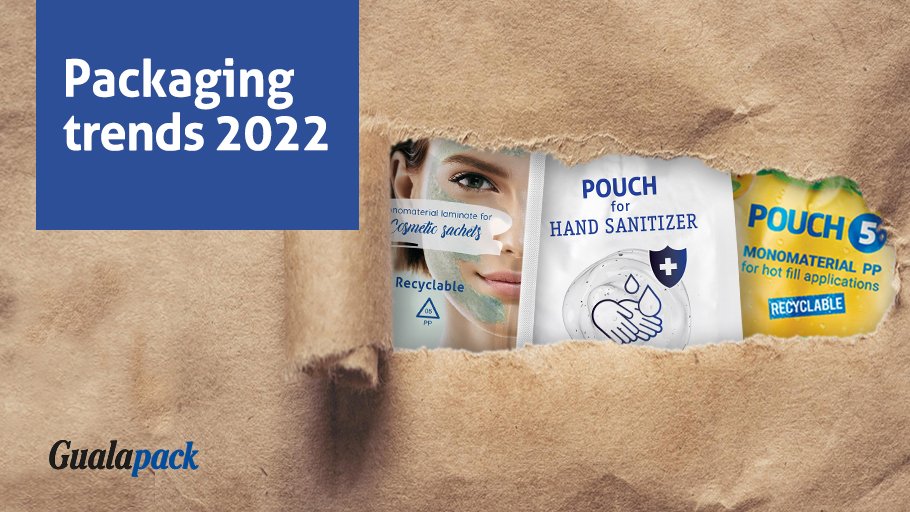From mono-material pouches to problem-solving design, Gualapack’s most recent product launches are at the forefront of major packaging trends for the new year and beyond.
Packaging this year will play a pivotal role in greater trends that are shaping the consumer experience worldwide. Hygienic safety, ease of use considering the widest possible range of individual needs, circularity, recyclability and a deeper environmental awareness in everything we do: all of these will be key for 2022 as Covid-19, climate change, the digital transition and inclusivity have made a deep impact on global culture. An impact that now demands physical and tangible solutions – such as packaging – to change, to keep up, and possibly even to find new answers to age-old problems.
Gualapack always keeps a careful eye on the market’s future evolutions: not only to seize important business opportunities, but also to provide clients with the best products for their needs considering the long-term impact of innovation. From this authoritative standpoint, we have identified the key trends for packaging in 2022 and beyond.
Making sustainable plastic possible
Plastic packaging has been under fire for years now, spurring innovative solutions to reduce, reuse and recycle. Many companies are doing away with excessive layers, designing bottles and jugs of thinner plastic, suggesting creative ways to re-use their containers.
A few brands also have the resources and determination to develop new products, and even new materials, to make recycling easier and more effective: Gualapack’s Pouch5, for example, is the first mono-material flexible pouch that can be sorted in the PP stream – cap included.
Even fewer organisations are able to use recycled plastic to create new products, avoiding waste in the landfills and giving materials new life: we were able to do just that in early 2022, partnering with SABIC to supply UK’s leading baby food brand Ella’s Kitchen with 3.5 million caps made of advanced recycled plastic for their pouches.
While it remains important to make changes without compromising the product inside or consumers’ experience, all of these different approaches together are contributing to making plastic more sustainable.
From ease of use to inclusivity
Ease of use and convenience have always been important features for packaging. Today, this trend is hugely enhanced by the needs of the ageing population, stronger awareness for individuals’ mobility challenges, and consumers’ demand for products that are effortless and don’t require tools or explanations. Winning packaging must be carefully designed not only to contain safely, but to be simply opened by anyone – so accessibility and inclusivity are embedded in the material as early as possible.
Easysnap, for example, was designed specifically to give everyone an intuitive and easy way to open a packet and dispense a liquid or creamy product – with just one hand.
Additionally, some companies are pushing ease of use to the next level and creating better experiences for customers either during the unboxing phase or when using the product: think ergonomic handles, non-slip plastic, even colour coding to make different products easier to identify. Gualapack’s Squeezer Cap, for example, makes it easy even for children to prepare their snacks by spreading cream cheese or jam on a slice of bread without using knives.
Efficient packaging for e-commerce
Delivery services and e-commerce have recorded huge growth since the beginning of the pandemic. According to The State of Online Marketplace Adoption, a global consumer survey by Mirakl, “70% of consumers worldwide now believe online marketplaces are the most convenient way to shop, while 66% prefer sites with online marketplaces over those that don’t.” This has had obvious consequences on logistics, which needs to guarantee safe and timely transportation while also optimising weight and volume of the goods – both for economic efficiency and reduced environmental footprint.
Shifting to flexible packaging can be the right solution in many cases: lightweight yet resistant, all of Gualapack’s pouches can contain and protect many different types of products even during long and complex shipping journeys, while still offering everyone – from warehouse managers to delivery people – a way to fill boxes and trucks more efficiently than rigid options.
Designed for maximum hygiene and minimum waste
On top of a marked increase in online shopping and capillary home deliveries, the Covid-19 pandemic has also led consumers to pay more attention to safety and hygiene. Plastic packaging is airtight and can be wiped down or disinfected if needed. It’s also convenient for single-dose products, which can replace larger containers that need to be passed around – for example, using ketchup sachets instead of condiment bottles in restaurants.
Plastic packaging can also efficiently portion quantities, or be resealed. This is especially important as smaller households and a more dynamic lifestyle become the norm, and “family-size” often translates into spoiled food that ends up wasted. The right pouch allows consumers to use the amount of product they need, and save the rest for later.
As global markets evolve we can only expect these trends will grow stronger, as consumers become more careful and interested about every aspect of their purchases. Far from being an afterthought, packaging is becoming part of the experience and decision process for people’s everyday needs and, more importantly, for long-term environmental protection. Our ongoing commitment to sustainability puts Gualapack in a prime position to offer solutions that meet the emerging needs in this scenario – not only for the quality and features of our products, but also because as a company we strive to be more sustainable in every aspect: from low-energy lighting in our factories to the use of renewable sources to power production.





